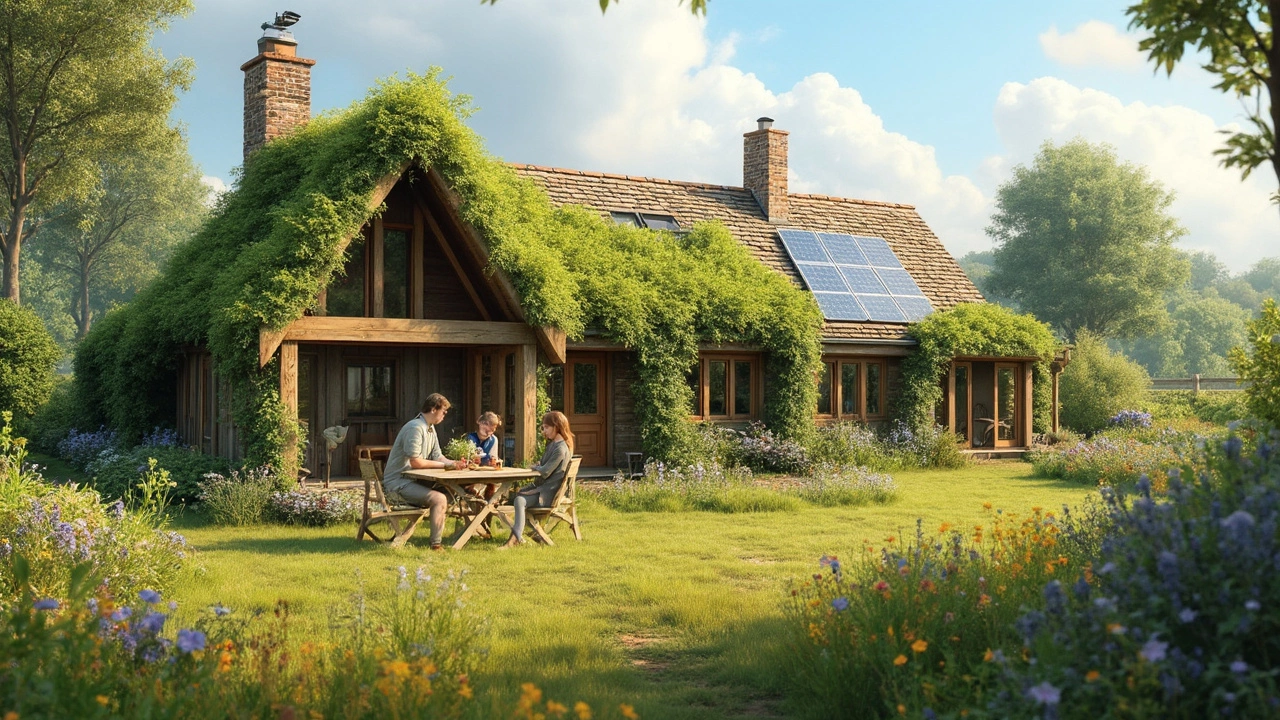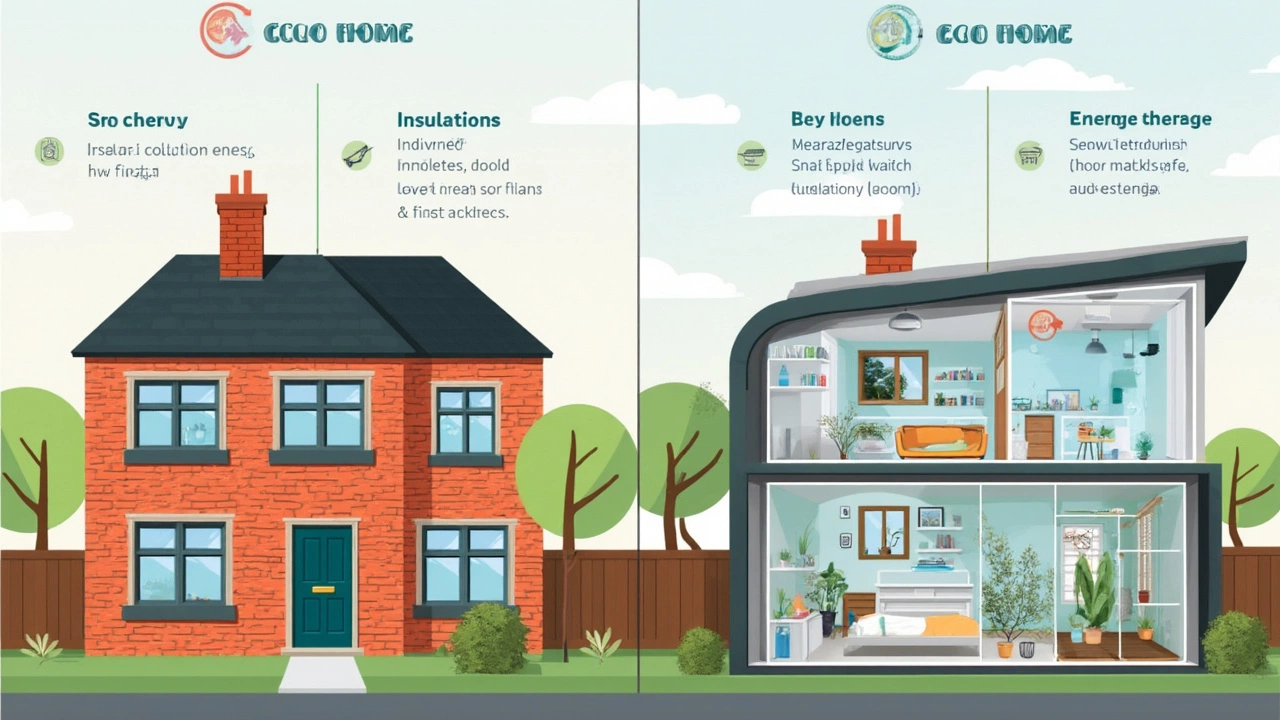Are Eco Homes Expensive? What You Really Pay For

The price of eco homes can trip people up. Maybe you’ve heard stories about fancy green cottages that cost a fortune. But is that always true? The real answer depends on what you want and how you go about it.
First off, not all eco homes have the same stuff. Some are high-tech, with solar panels on every inch of the roof, insulation made from recycled denim, and smart heating systems that learn when you’re out. Others are just regular cottages with some eco tweaks, like a rainwater barrel or energy-cutting windows. That’s why prices bounce all over the place.
If you’re dreaming of building (or buying) your own green cottage, don’t get scared off by sticker shock stories. It’s smarter to break down what costs extra and what might end up saving you money in the long run. Plus, there’s some sneaky ways to cut costs here and there, so you don’t have to give up on the eco dream. Ready to see where your money really goes?
- What Really Makes a Home 'Eco'
- Where the Extra Costs Come From
- How Eco Homes Can Save You Money
- Cheaper Ways to Go Green
- What to Know Before You Build or Buy
What Really Makes a Home 'Eco'
Forget about just adding a couple of plants or swapping one lightbulb. An eco home is about cutting your impact on the planet in ways that last. It’s built or fixed up to use fewer resources—like energy and water—and creates less waste. If you’re wondering what actually counts, here’s the real checklist:
- Using insulation that keeps heat in and bills down—think sheep wool, cellulose, or recycled denim instead of fiberglass.
- Installing windows that stop drafts and keep comfy temperatures inside all year.
- Choosing materials that are either recycled, locally-made, or grown in a way that doesn’t trash the planet. Bamboo floors and reclaimed timber are big ones.
- Setting up renewables like solar panels or heat pumps. These aren’t just for show; they slash regular bills and carbon emissions.
- Picking appliances and lights that sip energy, not guzzle it—look for top ratings on efficiency stickers.
- Using rainwater harvesting tanks or water-saving toilets and taps.
- Design that actually makes sense—big windows for natural light, good layout for cross-breezes instead of always running the AC.
If you like numbers, here’s how eco features can stack up against regular homes:
| Feature | Standard Home | Eco Home |
|---|---|---|
| Wall Insulation (R-value) | R-13 to R-19 | R-30 or higher |
| Energy Use (kWh/year) | ~10,649 | ~6,000 or less |
| Water Use (gallons/year) | ~90,000 | ~60,000 or less |
| Renewable Energy | Rare | Solar, heat pumps common |
You don’t have to tick every box to call your place eco-friendly, but the more you do, the bigger the payoffs for your wallet and the planet. And honestly, a bunch of these upgrades feel pretty nice to live with—nobody complains about lower bills and a draft-free living room.
Where the Extra Costs Come From
People get nervous about the price tag on eco homes for good reason—some of the materials just aren’t as cheap as standard stuff. Here’s the thing: building with sustainable wood, advanced insulation, and non-toxic finishes usually costs more right out of the gate. Plus, some of that tech—like fancy heat pumps or solar panels—doesn’t come cheap.
Let’s put some numbers on it. On average, eco homes can cost anywhere from 3% to 15% more to build than a regular home. It mostly depends on how extreme you go with the features. Super-insulated walls, triple-glazed windows, or a grass roof? Those little upgrades all stack up fast.
Breaking it down, here’s where most of the extra costs pop up:
- High-performance insulation: Think blown cellulose, sheep’s wool, or rigid foam—much more pricey than standard fiberglass.
- Windows and doors: Triple-glazed windows and super-sealed doors are way better against drafts but can cost double or more versus standard ones.
- Renewable energy systems: Solar panels, heat pumps, or geothermal systems are big upfront investments. Even basic solar systems can run $10,000 to $30,000.
- Materials and finishes: FSC-certified wood, low-VOC paints, and reclaimed tiles usually carry a higher price tag.
- Labor costs: Builders familiar with green techniques sometimes charge more. Eco designs can be trickier to build or need special skills.
Got a thing for data? Check out how the budgets usually break down between eco and standard builds:
| Feature | Standard Build Cost | Eco Home Cost |
|---|---|---|
| Basic Insulation (2,000 sq ft) | $3,000 | $6,500 |
| Windows & Doors | $8,000 | $15,000+ |
| Heating/Cooling System | $6,000 | $18,000 |
| Solar Panels | N/A | $20,000 |
| Low-Toxic Paint/Finish | $2,500 | $4,000 |
One thing to remember: the prices above are for new builds. If you’re upgrading an old cottage, expect to shell out a bit more for things like airtight retrofits or running new wiring for solar. And just to keep you guessing, local building codes in some areas now demand energy-saving features that push up costs even for regular houses—so the gap is shrinking in some places.

How Eco Homes Can Save You Money
People worry about spending more upfront on an eco home, but let’s talk about what happens after you move in. The biggest deal is with energy bills. Green cottages are built to waste less heat and use less power from the start. Think about triple-glazed windows, beefed-up insulation, and roofs built to keep warmth inside during winter (and outside during summer). According to the UK’s Energy Saving Trust, features like these can shrink heating bills by up to 40% compared to an older home without upgrades.
Solar panels might seem pricey, but they can pay off. A 2024 report from the Solar Energy Industries Association found that homeowners saved an average of $1,200 a year on electricity after installing a rooftop solar system. If you stick around in your eco home for ten years or more, those savings really build up.
Water use is another spot where these homes help your wallet. Low-flow taps and toilets, rainwater harvesting, and clever landscaping mean less wasted water and lower utility fees. Over just five years, these little tweaks can save hundreds of gallons of water for a family—even more if you live somewhere with expensive water.
Maintenance is another area most people don’t think about. Materials like metal roofs or fiber-cement siding last longer than traditional choices, so you don’t have to fork over money for repairs every few years. Eco paints and finishes are also less likely to crack or need touch-ups.
Some governments and towns offer sweeteners, too. You can sometimes snag rebates or tax credits for things like solar panels, energy audits, and buying a certified green home. It’s worth checking what’s available before you buy or build, because free money isn’t something you want to leave lying around.
All told, a eco home can save you cash every month, and the longer you stay, the deeper those savings get. While the upfront cost looks bigger, you can end up paying way less year after year just by living smarter.
Cheaper Ways to Go Green
You don’t have to go all in on fancy systems and rare building materials. There are affordable ways to get that eco cottage vibe without blowing your whole savings. Let’s break down a few straightforward options that keep things budget-friendly but still boost your eco game.
- Insulation upgrades. Good insulation is the unsung hero. Even just plugging gaps around windows and doors cuts heating and cooling bills big-time. Most people see a 10-20% dip in energy costs right away.
- Switch to LED bulbs. It’s boring but true: LEDs use up to 80% less energy and last way longer than old-school bulbs. They pay for themselves in a year or two—no joke.
- DIY rainwater harvesting. A basic rain barrel setup runs about $50 to $200, and can save hundreds on water bills, especially if you’ve got a garden, pets, or just love a green lawn.
- Upgrade appliances slowly. When the fridge dies, replace it with one that’s more energy-efficient (look for the ENERGY STAR sticker). Each upgrade chips away at your energy use.
- Natural landscaping. Skip the grass: native plants use way less water, need no fertilizers, and pull in the butterflies—triple win! Plus, you can find native options cheap or even free from community swaps.
Looking for help? Many cities and utilities actually hand out rebates for energy upgrades—think insulation, smart thermostats, or efficient windows. Sometimes it’s a few bucks, sometimes it’s several hundred. The Department of Energy keeps a directory of these programs, so it's worth a quick check based on your zip code.
| Upgrade | Estimated Cost | Annual Savings |
|---|---|---|
| LED Bulb Swap (whole house) | $100 | $75 |
| Rain Barrel | $150 | $130 |
| Insulation Gap Filling | $200 | $180 |
| ENERGY STAR Fridge | $700 | $40-$60 |
The best thing? You can start small. Stack enough of these moves and your cozy, eco home gets friendlier on your wallet with every change.

What to Know Before You Build or Buy
Before you jump into building or buying an eco home, there’s homework to do. Not all green cottages are built the same, and the decisions you make early on can affect your wallet for years.
Location always matters. Some regions have stricter building codes for eco houses. These codes can increase costs a bit, but they make sure your place actually lives up to expectations—think air quality, water management, insulation rules, and using certified sustainable materials. If you're building in a city, you might get utility rebates or tax incentives for going green. Rural areas, though, might not offer much help, so it pays to check with your local council before you start.
Next, look at builder experience. Not every construction company knows how to handle eco features, so hiring someone who has built these homes before can avoid headaches and surprise bills. Ask for examples of past work and check for any green building certificates.
Here’s a quick look at the average cost difference between regular and eco homes in the UK (2024):
| Type | Cost (per sq.m.) | Typical Lifespan Savings |
|---|---|---|
| Standard Cottage | £1,600 | — |
| Eco-Friendly Cottage | £1,900 | £18,000–£30,000 (30 years) |
Before you sign anything, ask about government help. The UK government offered the Green Homes Grant until 2022, and similar programs still pop up. Local councils or banks sometimes offer low-interest loans, rebates, or even solar panel grants. Missing these could mean paying more than you need to.
- Always get a full breakdown of costs from your builder, including materials, labour, and any extras specific to eco design (triple glazing, heat pumps, solar panels).
- Check warranties on big-ticket items, especially energy systems—they can be pricey to repair and some come with 20-25 year warranties.
- Think about your daily life: Will you really use a rainwater collection system? Do you want a wood-burning stove or just a heat pump? Don’t pay for features you won’t use.
- Budget for higher upfront costs but plan for utility bill savings. Homeowners typically save 30-50% on energy compared to standard homes.
Last tip: Visit real eco cottages before you decide. Ask owners what they’d do differently. There’s no better way to spot the hidden savings—or hidden headaches.